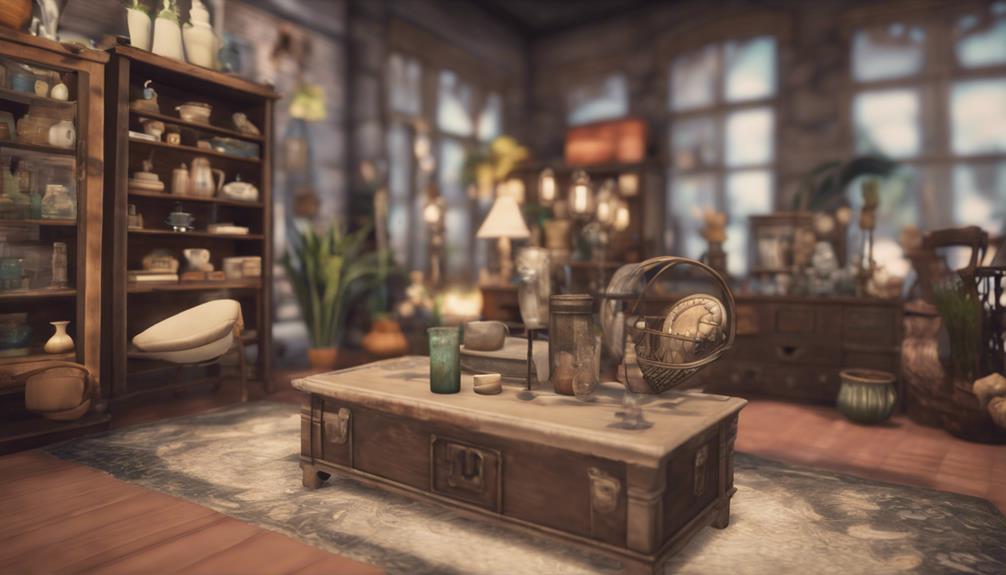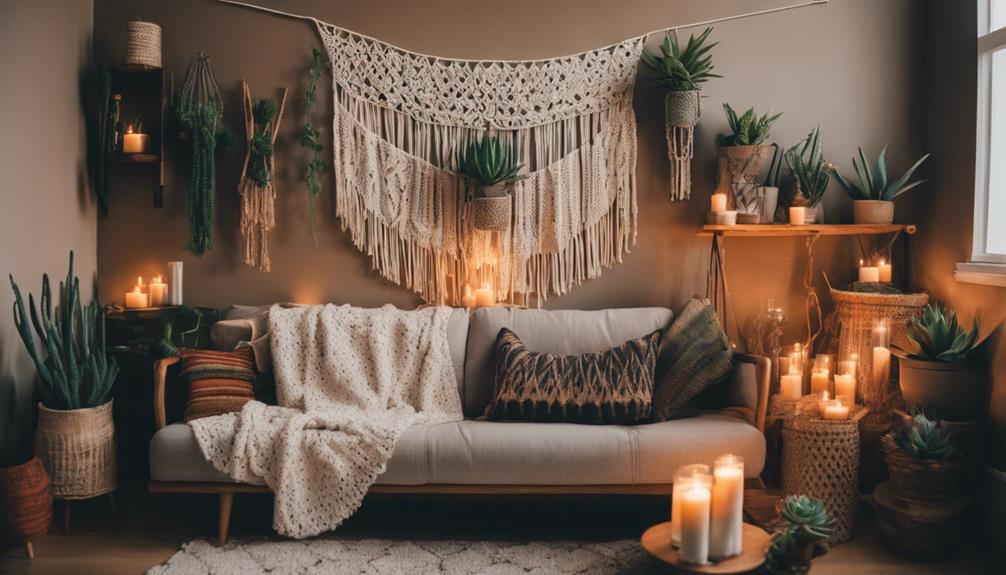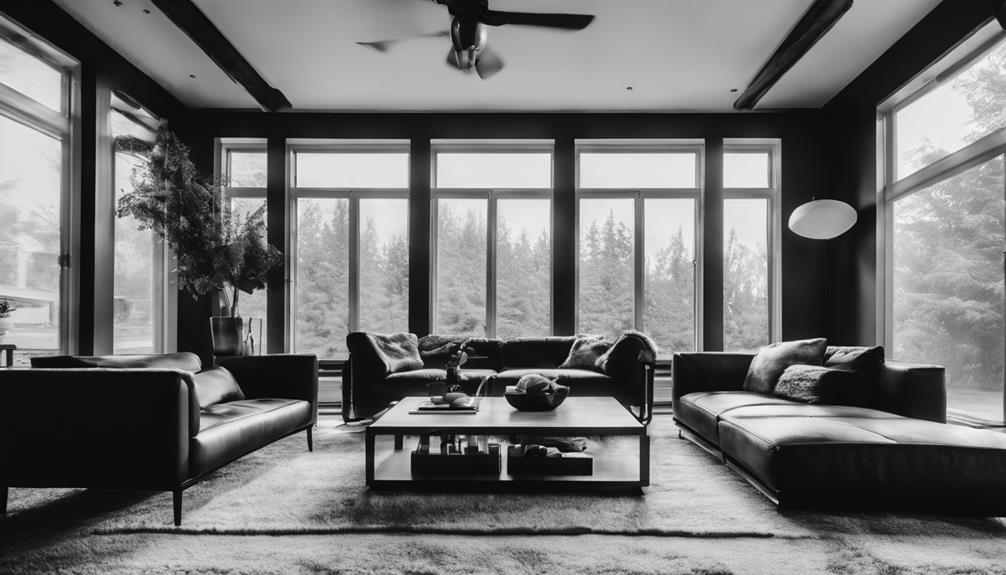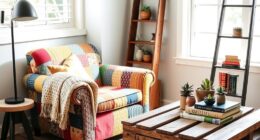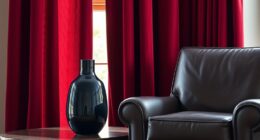Incorporating batik into your home’s interior design can elevate your space with its vibrant colors and intricate patterns. These unique fabrics add both texture and cultural narratives, making your decor truly stand out. Whether you opt for batik cushions, framed artwork, or curtains, you are embracing a rich heritage that speaks volumes. Combining batik with modern decor creates a stylish contrast that can revitalize any room. Additionally, batik’s sustainable production practices align with contemporary values. If you are looking to create a home that reflects your personal style while honoring tradition, there is much to discover about how batik can enhance your spaces.
Key Takeaways
- Batik fabric adds vibrant colors and intricate patterns, enhancing the aesthetic appeal of various interior spaces.
- Incorporating framed batik art creates focal points, reflecting cultural heritage and elevating modern decor.
- Batik cushions and throws introduce warmth and personalization, making living areas feel inviting and stylish.
- Mixing traditional batik with contemporary furnishings creates a dynamic and eclectic atmosphere, appealing to diverse design tastes.
- Sustainable batik production practices contribute to eco-friendly home decor, appealing to environmentally conscious consumers.
The Cultural Significance of Batik

Batik is more than just a fabric; it's a vibrant tapestry of cultural identity and heritage. Originating in Java, Indonesia, batik serves as a crucial expression of Indonesian culture, intertwining traditional motifs and symbolic imagery into intricate patterns that narrate stories unique to local communities.
Each design conveys deeper meanings, representing social status, cultural narratives, and spiritual beliefs, allowing you to appreciate its role as a visual language for cultural expression. Additionally, similar to Indonesian decor masks, batik enhances the aesthetic appeal of any space, creating a unique atmosphere that reflects rich cultural traditions.
When you incorporate batik into your interior design, you're not just adding a decorative element; you're embracing a rich cultural heritage. Traditionally used during significant life events like weddings and ceremonies, batik garments are often passed down as family heirlooms, highlighting their importance in maintaining cultural continuity.
The craftsmanship behind batik, particularly in techniques like Batik Tulis (hand-drawn) and Batik Cap (stamped), showcases a meticulous process that has been preserved across generations.
As modern influences continue to shape design trends, batik retains its roots as a symbol of Indonesian heritage, enriching your space with both beauty and meaning. When you choose batik, you celebrate the artistry and stories woven into each piece.
Techniques and Variations of Batik
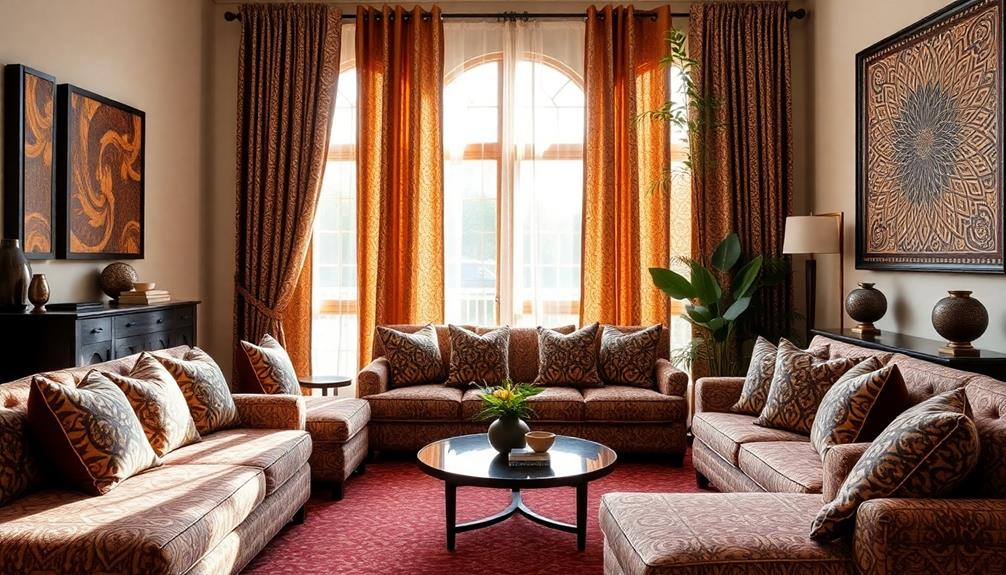
When exploring batik techniques, you'll find a fascinating range from the intricate hand-drawn methods of Batik Tulis to the quick efficiency of stamped Batik Cap.
These techniques are often paired with unique decor elements such as Indonesian Decor Masks that enhance the cultural richness of a space.
Modern painting variations like Batik Lukis offer fresh creative possibilities, pushing the boundaries of traditional designs.
Each technique not only highlights the artistry involved but also reflects the rich cultural heritage of batik.
Hand-Drawn Batik Techniques
There's something truly enchanting about the artistry of hand-drawn batik techniques, particularly Batik Tulis. This traditional method involves artisans meticulously drawing intricate designs with a canting tool, a process that can take weeks to complete. The beauty lies in the wax-resist dyeing technique, where molten wax is applied to fabric before it's dyed, allowing for unique patterns that are exclusive to each artisan.
Batik Tulis isn't just about aesthetics; it boasts deep cultural significance. The vibrant colors come from natural dyes derived from plants and minerals, making each piece not only a work of art but also a storytelling medium. Such patterns often carry symbolic meanings, connecting you to rich traditions.
If you're considering incorporating Batik Tulis into your interior decor, here's a quick comparison of this technique against other batik styles:
| Feature | Batik Tulis |
|---|---|
| Technique | Hand-drawn |
| Time Investment | Weeks per piece |
| Cost | More expensive |
| Color Source | Natural dyes |
| Cultural Significance | Deeply symbolic |
With Batik Tulis, you're not just adding fabric; you're infusing your space with history and artistry.
Stamped Batik Production Methods
While hand-drawn Batik Tulis showcases the painstaking artistry of individual artisans, stamped batik, or Batik Cap, streamlines the process with its efficient use of copper stamps. This technique allows you to produce intricate batik patterns more quickly, making it an appealing choice for modern interiors and home decor.
Stamped batik not only enhances aesthetic appeal but also reflects the rich cultural heritage of Indonesia, offering a vibrant addition to Indonesian Decorative Pillows.
In stamped batik, artisans dip the copper stamp into wax before applying it to the fabric, creating uniform designs that reflect traditional motifs. When the fabric is dyed, the wax resists the dye, resulting in beautifully detailed patterns that are both repeatable and visually striking.
Recognized by UNESCO as a cultural masterpiece, stamped batik preserves the rich heritage of batik craftsmanship while meeting contemporary needs.
Modern stamped batik production often utilizes synthetic dyes, enhancing color vibrancy and durability. This means you can enjoy the beauty of batik in various applications, from upholstery to decorative accents, all while appreciating the cultural significance behind each piece.
Embracing stamped batik in your home decor not only adds style but also honors the artistry and traditions that have shaped this exquisite craft.
Modern Painting Variations
Modern painting variations of batik have evolved to incorporate innovative techniques that blend tradition with contemporary artistry. This exciting shift allows batik artists to create stunning batik fabrics that are perfect for modern interior design, enhancing spaces with a touch of cultural richness and natural beauty as seen in Balinese design characteristics.
Here are some variations you should know about:
- Batik Tulis: The most traditional batik, hand-drawn with a canting tool, resulting in unique and intricate designs.
- Batik Cap: This stamped technique enables faster production of uniform geometric patterns, recognized by UNESCO for its cultural significance.
- Batik Lukis: Involves painting directly on undyed fabric, allowing for modern designs that showcase creativity and vibrant colors.
- Batik Pesisir: A coastal style that embraces trade influences, often featuring bold colors and designs suitable for both fashion and decor design.
These modern variations reflect a blend of traditional batik techniques and contemporary aesthetics.
Incorporating Batik in Home Decor

Incorporating batik into your home decor can transform your living space with vibrant colors and intricate patterns. Batik fabric is versatile and can be used in various applications, such as cushions, throws, and curtains. These additions enhance modern decor while introducing rich cultural elements that celebrate unique artistry.
Additionally, when combined with traditional Indonesian style home decor, batik can create a harmonious atmosphere that reflects local culture. Consider framing batik art to create focal points in your rooms. This not only elevates your interior designs but also honors the heritage of the fabric.
If you want a sophisticated touch, use batik in upholstery, pairing it with neutral tones to allow the patterns to shine. Floor-to-ceiling batik panels can add character and warmth, making them perfect for feature walls or as room dividers in open-concept spaces.
Don't overlook smaller batik accents, like table runners or decorative trays. These pieces offer versatile options that can seamlessly blend into both modern and bohemian decor styles.
Batik's Impact on Aesthetics

When you incorporate batik into your space, the colorful patterns immediately catch the eye, transforming the room's dynamics.
These vibrant designs not only add a visual punch but also weave in cultural symbolism, enriching your decor with deeper meaning.
Batik can beautifully complement other cultural elements, such as Indonesian decor masks, enhancing the storytelling aspect of your interior design.
Plus, batik's versatility means you can use it in countless ways, from accent pillows to statement art pieces, making it a perfect fit for any style.
Colorful Pattern Dynamics
Vibrancy and intricacy define the allure of batik fabrics, making them a powerful tool in interior design. As seen in many luxury tropical design aesthetics from Bali, you can transform your space by incorporating batik designs, which introduce vibrant colors and visual interest that breathe life into any room.
Here's how batik can elevate your home decor:
- Color Play: Mix and match bright, bold batik patterns to create an energizing atmosphere.
- Texture Addition: Use batik cushions or wall hangings to add depth and inviting texture against solid surfaces.
- Design Versatility: Whether you lean towards bohemian or contemporary styles, batik complements various design aesthetics effortlessly.
- Sophisticated Touch: Opt for muted batik colors to cultivate a refined ambiance, balancing vibrancy with elegance.
Cultural Symbolism Integration
Batik patterns aren't just visually striking; they carry rich cultural narratives that can profoundly influence your interior design. These intricate designs serve as decorative elements that convey deep cultural symbolism, reflecting social status, heritage, and local stories.
Additionally, the integration of batik in modern Indonesian homes highlights the importance of preserving cultural identity amidst changing urban landscapes, as seen in traditional Indonesian housing. When you incorporate batik into your home, you're not just adding color; you're telling a story and celebrating craftsmanship.
The vibrant colors and unique motifs of batik textiles create a warm atmosphere, allowing you to connect with nature and tradition.
Whether you choose batik cushions, tapestries, or wall hangings, these pieces enhance the aesthetic appeal of both modern and bohemian styles. They offer a perfect blend of individuality and harmony, transforming your living space into a narrative of cultural identity.
Versatile Design Applications
The unique allure of batik extends far beyond its cultural significance; it offers countless applications in interior design that elevate any space. By incorporating batik, you create a vibrant atmosphere that showcases your personal style while also paying homage to traditional artistry, such as Indonesian wedding decor ideas that beautifully integrate batik patterns.
Here are four versatile design applications to contemplate:
- Upholstery: Use batik fabric to reupholster furniture, adding unique texture and intricate patterns that enhance the overall aesthetic of your living spaces.
- Wall Art: Frame batik pieces as wall art to create vibrant focal points, reflecting cultural heritage while adding visual interest to any room.
- Soft Furnishings: Introduce batik through cushions and throws. These elements add warmth and depth, making your space feel inviting and personalized.
- Eclectic Decor: Mix batik patterns with other design elements to achieve a modern and eclectic look, striking a harmonious balance between tradition and contemporary aesthetics.
Modern Trends in Batik Design

In recent years, modern batik design has transformed, embracing vibrant colors and contemporary motifs that suit a variety of interior styles. You'll find that designers now creatively use batik fabric in upholstery, wall hangings, and decorative accessories, adding unique texture and cultural depth to your space.
This trend allows you to mix traditional batik patterns with modern furnishings, creating a dynamic interplay of old and new that results in visually interesting and harmonious environments. Incorporating elements of tropical contemporary design can further enhance the aesthetic, bridging the gap between cultural heritage and modern living.
Moreover, the rise of sustainable textiles has made handmade batik increasingly popular among eco-conscious consumers. This reflects a growing appreciation for artisanal craftsmanship and cultural heritage, which you can showcase in your home.
Modern batik patterns are also being reinterpreted in innovative ways, such as through abstract designs and digital prints, appealing to younger generations.
Whether you're aiming for a bohemian vibe or a minimalist aesthetic, modern batik design offers a versatile choice for enhancing your interior. By incorporating these vibrant pieces, you'll not only beautify your space but also celebrate the rich history and craftsmanship behind batik.
Sustainable Practices in Batik Production

Sustainable practices in batik production are gaining traction as artisans harness natural dyes from plants, greatly reducing the use of harmful synthetic chemicals. By focusing on eco-friendly production methods, these local artisans not only care for the environment but also preserve traditional craftsmanship.
Here's how they're making a difference:
- Natural Dyes: Using plant-based dyes, artisans create vibrant colors while minimizing ecological impact.
- Upcycling Materials: Many producers repurpose fabric scraps, transforming waste into stunning new designs.
- Fair Trade Practices: Supporting local artisans guarantees they receive fair compensation, fostering community growth and ethical production.
- Water and Energy Efficiency: Traditional methods employed require less water and energy than industrial processes, promoting sustainable practices.
These initiatives emphasize education and training, guaranteeing that knowledge is passed down through generations.
By choosing batik for your home, you're not just adding style; you're also supporting eco-friendly production and the well-being of local artisans.
Embrace the beauty of batik while contributing to a sustainable future, making your interior spaces not just stylish but also ethically conscious.
Batik as a Personal Style Statement

Embracing batik in your home decor creates a vibrant personal style statement that reflects your unique heritage and individuality. The intricate designs and cultural motifs found in batik patterns bring a sense of authenticity and warmth to your interior design.
By incorporating batik fabrics, you can infuse your space with vibrant colors that transform even the simplest rooms into inviting havens.
Using batik in accent pieces like cushions or wall hangings adds depth and texture, enhancing the overall aesthetic of modern and eclectic interiors. This versatility allows batik to blend seamlessly with various design styles, from bohemian to contemporary, making it a perfect choice for expressing your personal style.
Moreover, each authentic batik piece showcases the craftsmanship and artistry involved in its creation. By choosing to display these unique artworks, you not only elevate your home's decor but also make a statement about your appreciation for cultural heritage and unique artistry.
Frequently Asked Questions
How Do I Care for Batik Fabric in My Home?
To care for batik fabric, wash it gently in cold water with mild detergent. Avoid direct sunlight to prevent fading, and iron on low heat. Store it flat or hang to maintain its shape.
Can Batik Be Used in Outdoor Decor?
Batik can brighten outdoor decor like a splash of color in a garden. It adds unique patterns to cushions, tablecloths, or umbrellas, creating a vibrant atmosphere. Just make certain it's protected from harsh weather to maintain its beauty.
Where Can I Buy Authentic Batik Fabric?
You can buy authentic batik fabric at local craft markets, specialty textile shops, or online retailers like Etsy and Amazon. Don't forget to check for reviews to guarantee you're getting genuine products!
Is Batik Suitable for All Interior Design Styles?
Batik can definitely enhance various interior design styles. It adds unique patterns and colors, fitting seamlessly into contemporary, bohemian, or even traditional spaces. You'll find it brings warmth and character to your home effortlessly. For those looking for a fresh and modern twist, modern batik designs offer a contemporary take on this traditional art form. With their clean lines and bold colors, they can complement minimalist or mid-century modern interiors with ease. Whether used as throw pillows, drapery, or wall art, modern batik designs can bring an unexpected and stylish touch to any room.
How Do I Mix Batik With Other Patterns?
Mixing batik with other patterns can be fun! Start by choosing complementary colors, then layer different designs. Balance bold batik with subtler patterns, and don't hesitate to experiment until you find what feels right for your space.
Conclusion
Incorporating batik into your home isn't just about aesthetics; it's about embracing a rich cultural heritage that tells a story. When you choose batik pieces, you're not only enhancing your space but also supporting sustainable practices and artisans who pour their heart into every design. Imagine the warmth and character a beautiful batik throw or wall hanging can bring to your home. It's more than decor; it's a personal style statement that connects you to a vibrant tradition.



